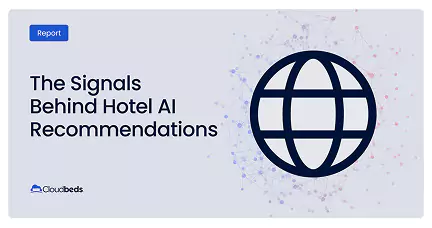
It’s Monday morning, and your department heads are each armed with their wins.
Sales exceeded their group booking targets for the quarter. Marketing is celebrating record-low CPAs from a recent paid campaign. Revenue management held strong on rate, even during a shoulder period.
But despite all the “wins,” your forecast is soft, your profit margins are thin, and your rooms weren’t as full as they could have been.
What happened?
Each team did its job, but they weren’t working toward the same outcome. Sales brought in volume during low-yield periods. Marketing pushed promotions that undercut rate strategy. Revenue protected pricing, but missed an opportunity to drive long-stay value.
This is the reality for many hotels: good intentions but siloed results.
The fix isn’t more meetings. It’s a new model—a commercial strategy—where marketing, sales, and revenue management operate as one team with shared goals, shared data, and a single mission: drive total profitability.
The era of baby steps is over
Revenue management, sales, and marketing have been inching toward collaboration for years—but barely.
Back in 2011, the book The Cornell School of Hotel Administration on Hospitality: Cutting Edge Thinking and Practice noted that revenue management was “evolving into demand management, integrated with sales and marketing.” This meant moving beyond just filling rooms to building profitable, lasting customer relationships.
Six years later, a Cornell survey of 400 revenue professionals showed that this evolution had stalled. Nearly half of revenue managers reported to sales or marketing leaders, while the rest remained siloed.
Meanwhile, an HSMAI survey revealed that revenue professionals were spending less than half their time on actual revenue-generating activities—and only 2–3% were interacting with sales and marketing teams.
3%
of revenue professionals are interacting with sales & marketing teams.
The operational model where three separate teams work toward profitability is broken, and we should start looking at it like Gen Z looks at 1980s videos in bewilderment, wondering how anyone could ever wear shoulder pads.
We need to stop trying to get three disconnected teams to “collaborate better” and start building one unified commercial strategy team operating from a shared vision.
What is a hotel commercial strategy?
A commercial strategy is a unified approach to managing all revenue-generating functions—sales, marketing, and revenue management—under a single, coordinated strategy.
It’s not just collaboration. It’s a new operating model: one cross-functional team, led by a commercial manager, using shared data, shared KPIs, and shared accountability to increase the bottom line.
Lori Kiel, SVP of Revenue Management at Pyramid Global Hospitality, broke down what commercial strategy means and the importance of it today during an episode of The Turndown, saying that “it truly is the way of the future.”
Tune in to The Turndown.
Listen to the full episode with Lori Kiel from Pyramid Global Hospitality.
Why now?
Rising OTA fees, a changing search landscape, and guest demands for personalization require a more sophisticated approach, and today’s integrated platforms finally make it possible.
AI is changing the game, rewriting hotel revenue generation rules. Platforms like Cloudbeds connect previously isolated hotel systems, eliminating data silos that have fragmented hotel operations, while causal AI identifies cause-and-effect relationships in market trends that were invisible just years ago.
Even better: this technology is now accessible to independent hotels, not just major chains. For the first time, properties of all sizes can eliminate the two fundamental problems that have plagued hotel revenue generation:
1. Fragmented data and misaligned incentives
Each team chases different metrics and produces separate reports from systems that don’t communicate. Revenue management obsesses over RevPAR and its components—ADR and occupancy—, marketing celebrates ROAS and campaign clicks, and sales is often left focusing on volume and undercutting their compset.
2. Slow decision-making
There is little sharing of insights, leading to slow, often misguided decisions. The market keeps evolving. By the time three departments coordinate a response, opportunities disappear and everything lags behind the market.
The anatomy of a commercial strategy
In hotel commercial strategy, sales, marketing, and revenue management are like three legs of a stool: all are needed and none of them—not even two—can support it alone.
But here’s the shift: in a true commercial strategy, these aren’t just departments. They’re interconnected functions operating as one team, with shared data, shared goals, and shared accountability.
Here’s how these are going to evolve in the commercial strategy era:
Revenue management
Combines historical with forward-looking data, creating insights into demand that make pricing decisions strategic rather than reactive. Pricing decisions no longer aim to fill rooms in the short term but consider the long-term value of guests. Distribution strategy also matures, with a sharper focus on channel profitability and guest ownership, prioritizing direct bookings and long-term loyalty over short-term volume
Marketing
Owns the “up-funnel” strategy, understanding price sensitivities and travel motivations across different guest segments, and crafting campaigns that attract profitable guests without eroding margins through blanket discounts. This involves deep segmentation based on price sensitivity and booking behavior, and the ability to transform customers into direct-booking advocates who choose guest experience over discounts.
Sales
Evolves into strategic account management, owning the relationships that drive long-term value—particularly with corporate accounts and group business. While sales teams still negotiate rates and manage volume discounts, they now juggle group dynamics: Will the block actually fill? How much attrition should we expect? When should we release unsold rooms? Its goal is to maximize account value, recognizing that real group business money often comes from meetings, catering, and additional services.
Data as the connective tissue
Data is no longer scattered across spreadsheets and siloed systems. It’s the glue that binds the team, a single source of truth that gives everyone the same visibility, context, and opportunity to act. Unified, real-time data transforms isolated insights into commercial intelligence, empowering faster decisions, smarter strategies, and collective accountability.
How to build a commercial team
To ensure your commercial team isn’t just reshuffled departments, it needs a new structure, mission, and operating model.
1. Appoint a commercial leader
This isn’t about adding a new title, but creating a new mindset. Someone needs to own the full commercial vision, drive alignment, and hold the team accountable to shared goals. Most often, this role falls to a revenue leader who’s already moved beyond rate and inventory to think strategically across pricing, demand, and hotel performance.
2. Align goals and metrics
A commercial team operates from one scorecard. That means shared KPIs like total revenue per available room (TRevPAR), direct booking share, and net profit per segment, not isolated marketing campaign metrics or top-line revenue. Incentives shift too: no more departments chasing their own wins. Everyone succeeds (or fails) together, based on total profitability.
3. Connect technology
You can’t align teams without aligning your data. A connected tech stack—like Cloudbeds PMS with integrated RMS, CRM, and business intelligence tools—gives every department access to the same real-time insights. AI then brings it all to life, analyzing trends, predicting demand spikes from local events, and surfacing the impact of pricing strategies or promotions across segments.
4. Cross-train and collaborate
While unified leadership, goals, and data provide a foundation, commercial teams need genuine collaboration where each member understands what everyone does.
That means:
- Weekly commercial check-ins
- Shared dashboards and reports
- Joint planning for campaigns and pricing
Marketers learn to read RevPAR reports. Revenue managers understand customer acquisition costs. Sales teams grasp guest lifetime value.
What this looks like in practice
Commercial strategy requires a mindset shift that eliminates hand-offs between teams and creates a shared mission where everyone speaks the same language. Here are some common plays that bring commercial strategy to life:
Forecast-based campaigns
AI identifies soft demand for upcoming dates. Revenue sets a limited discount window, and marketing targets high-intent guests via digital marketing channels, filling gaps before they become problems.
In practice: A 200-room city hotel sees low midweek occupancy in February. The team launches a “Work from Hotel” initiative targeting past solo travelers within 150 miles.
High-value segment targeting
New insights allow teams to identify high LTV segments of long-stay guests. Sales and marketing create long-stay offers based on revenue management’s rate plans.
In practice: A coastal resort identifies remote workers booking 10+ night stays in shoulder season. The team builds a discounted long-stay package with weekly housekeeping and co-working perks
Channel optimization
Instead of defaulting to OTAs to fill rooms, commercial teams launch direct campaigns targeted at new and existing guests, with different offers based on the price sensitivity of each segment.
In practice: A boutique hotel in Lisbon sees rising OTA bookings from weekend couples. Marketing adds direct booking perks like early check-in and welcome drinks for that segment.
Local demand capture
When local events are announced, the team builds a 360º plan with themed campaigns, rate adjustments, and group packages to capture direct demand.
In practice: When a major food festival is announced in Austin, a hotel builds a local offer that includes early check-in and a free shuttle to the venue. The team promotes it through paid social media and email, filling the weekend directly.
Corporate and group demand balance
Teams align to determine peak periods with high transient demand and those needing group and corporate business.
In practice: A conference hotel in Chicago sees strong Saturday pacing but weak Tuesday occupancy. The team restricts group rates over the weekend and focuses on midweek outreach to regional companies.
Change or risk being left behind
Alignment of hotel revenue management with sales and marketing won’t eliminate silos in the hospitality industry. Hotel-wide commercial strategy will. This convergence requires new reporting hierarchies, processes, job descriptions, and mindsets.
The change is happening. A recent HSMAI report reveals that 34% of North American members are either leading commercial effectiveness or well on their way, while 39% report some progress. Hotels that delay this transformation risk being left behind by competitors already making the shift.
Build your commercial engine.
With Cloudbeds, align your commercial teams for powerful decision-making.



